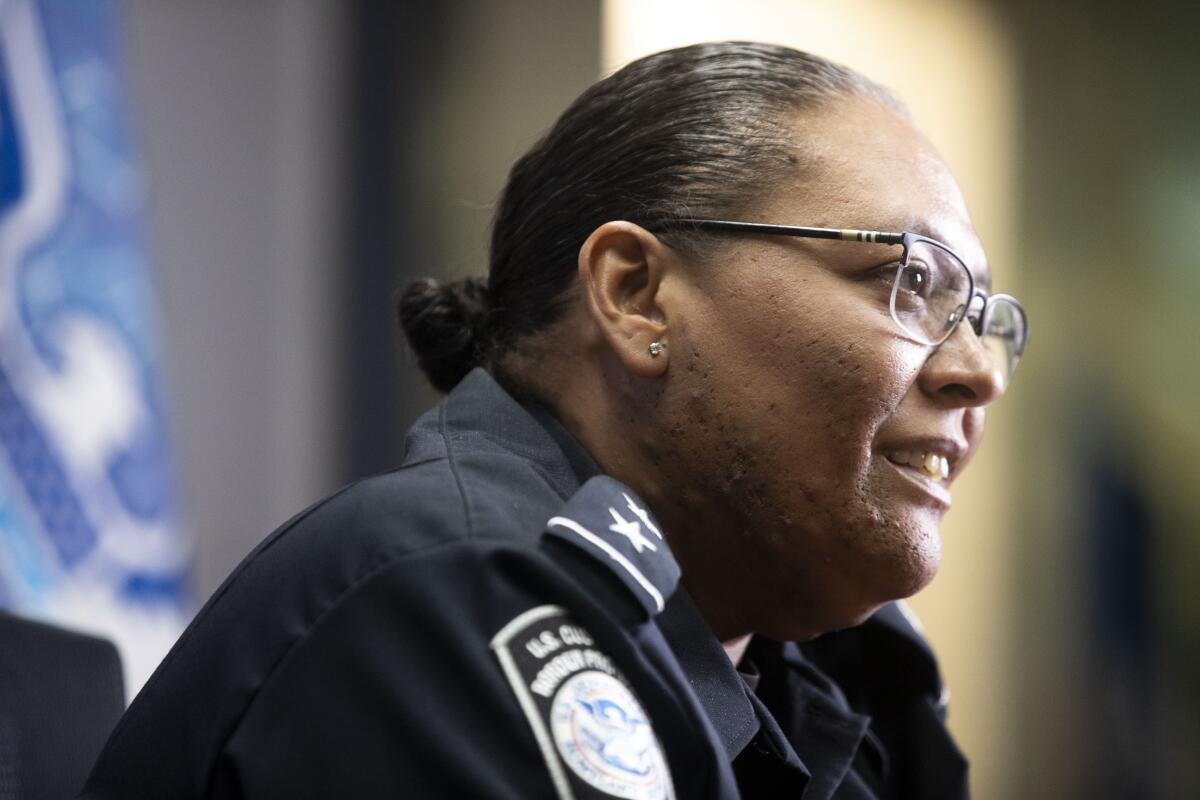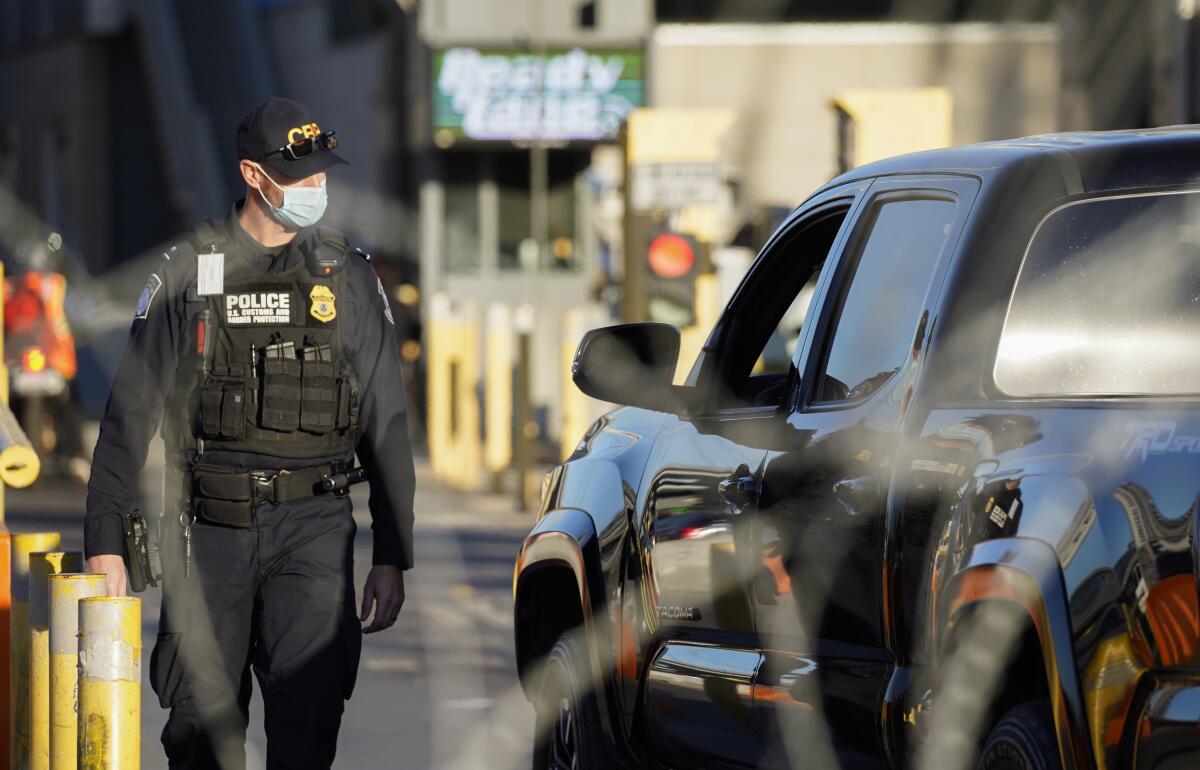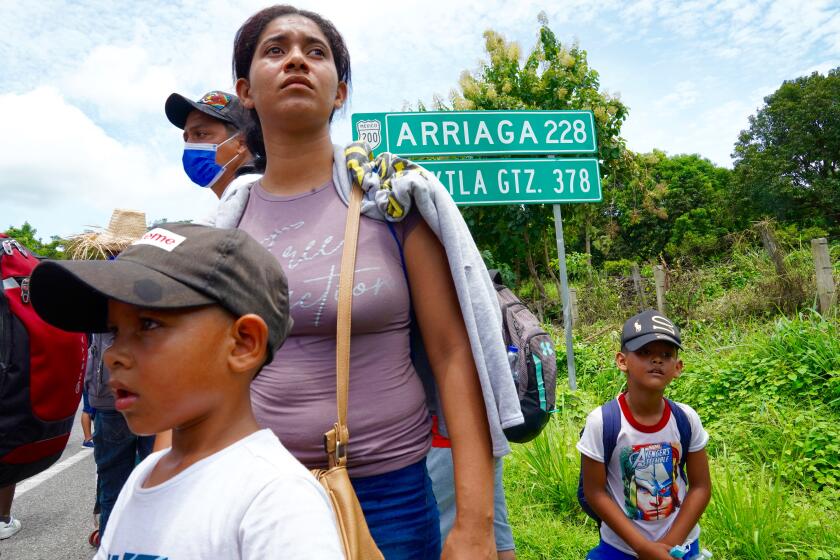For first time, a woman heads San Ysidro border crossing, one of the world’s busiest

- Share via
SAN DIEGO — The San Ysidro Port of Entry, one of the busiest land border crossings in the world, is for the first time in its history being run by a woman.
Port Director Mariza Marin was officially promoted to the position in August after overseeing San Ysidro in an acting role for months. Her predecessor, Sidney Aki, is now in charge of the U.S. Customs and Border Protection San Diego field office.
Marin, born and raised in San Diego, has spent most of her nearly 14-year career with CBP working at the port of entry between her hometown and Tijuana. She hopes that her intimate knowledge of the portal and its workforce will help her address the challenges that she sees as a high priority in her new position.
“I’ve never felt and never wanted to feel like I have to prove myself as the first woman port director,” Marin said in a recent interview, “but I do want to prove myself as a good port director, regardless of gender.”
Marin worked in the car insurance industry until her aunt convinced her to apply for a position with CBP.
Because of the active lifestyle of her youth, Marin said, she gravitated to work that kept her away from a desk.
And she felt a personal connection to the mission of stopping drugs from getting into the United States. Three of her uncles died when she was a child because of narcotics overdoses, she said.
“I think it was a natural fit for me to believe in the mission and give back,” Marin said.

Her career with CBP began in Long Beach, but she soon transferred to San Diego to be closer to her family. She moved up through the ranks, for a while working as the watch commander in charge of processing asylum seekers and other people who didn’t have permission to enter the U.S. in the port of entry’s basement.
Marin noted that she’s had other women in leadership roles to follow at CBP. She said some of them, including her aunt, faced much more adversity in getting promoted to leadership than she did.
“I’ve been fortunate to allow my work ethic to speak for itself, but I think that it’s an honor to kind of be the one to break that ceiling and be a testament for the change that’s needed in this agency,” she said.
Now, she’s in charge of all of the operations at the port of entry as well as the Cross Border Xpress — a special border crossing for people flying into and out of the Tijuana airport.
That work includes finding ways to improve detection of the ever-increasing quantities of fentanyl being sneaked through the port of entry. About 54% of the fentanyl found coming through ports of entry in fiscal 2022 through August was in the San Diego area, according to CBP data.
Customs and Border Protection says wait times regularly surpass two hours in regular passenger vehicle lanes.
It also includes figuring out how to reduce wait times for northbound traffic and planning for an increase in asylum processing in anticipation of the end of a pandemic policy that currently turns back many migrants before they reach U.S. soil.
She said all of these issues are top of mind as she officially moves into her new role. She hopes to do all of that while bringing better work-life balance to her employees.
The key to drug detection and wait times, she said, will be to leverage technology to improve efficiency. She said CBP is particularly looking into ways to increase “nonintrusive inspection technology” between the international border line and the inspection booth in the vehicle lanes. That could include additional scanners as well as finding a way to add the facial recognition cameras currently used to screen pedestrians heading north to San Diego to quickly confirm identity.
“I can’t staff my way out of some of our shortcomings,” she said.
Also heavy on her mind are calls to reopen PedWest, one of two pedestrian routes through the port of entry. CBP closed PedWest, whose northern end facilitates travel to and from the Las Americas outlet mall and other nearby San Ysidro businesses, at the outset of the pandemic and has relied on the other route, known as PedEast, whose northern end is next to the end of the San Diego trolley line.
Marin blamed the continued closure on a backlog in training new staff caused by the shutdown of CBP academy classes during the pandemic.
“In a calmer pandemic world, we are working to get healthier in onboarding officers,” Marin said. “I am looking at every option to open PedWest. I understand the value of PedWest and San Ysidro in general to our economy.”
But she doesn’t yet know when that will happen.
“While I’m committed to opening it, I don’t have a time frame just because of the backlog in onboarding new officers. I am constantly reassessing what my workforce looks like and looking to reopen as soon as possible,” Marin said. “In the interim, my commitment is to open as many lanes — and particularly during high-commute hours open all lanes — on the east side to try to mitigate high traffic.”

In terms of asylum processing, she sees a move away from the holding cells of which she used to be in charge. For years, asylum seekers have complained of the frigid conditions of the hielera, or ice box, the nickname they gave the CBP cells.
Marin said that change is already taking place for about 180 people a day who, through nonprofits, apply and are accepted as special exemptions to the pandemic rule that turns most away.
That policy, known as Title 42, blocks people who do not have permission to enter the United States from doing so and allows immigration officials to expel people who cross anyway.
Title 42 is a public health policy that’s being used to determine whether immigrants can cross the border. Here’s how it works.
Under Title 42, CBP officers standing at the international boundary line inform asylum seekers that they cannot request protection at this time. They’re told they have to get in touch with the nonprofits to request exemptions.
Those who are granted entry into the U.S. under the exceptions are generally not placed in holding cells, unless officers come across red flags in their background checks or vetting databases.
“Maintaining a legal pathway, I think, is key,” Marin said. “It is an orderly flow. They are provided a quiet, dignified experience and they are processed as efficiently as possible and not entering a detention setting unless there is a threat. I think that’s the way forward as the end of Title 42 comes.”
The challenge, she said, will be to work with the rest of the government to smooth out bottlenecks that arise with other agencies in the asylum process that sometimes have delayed CBP’s ability to get people out of its custody.
More to Read
Sign up for Essential California
The most important California stories and recommendations in your inbox every morning.
You may occasionally receive promotional content from the Los Angeles Times.
















